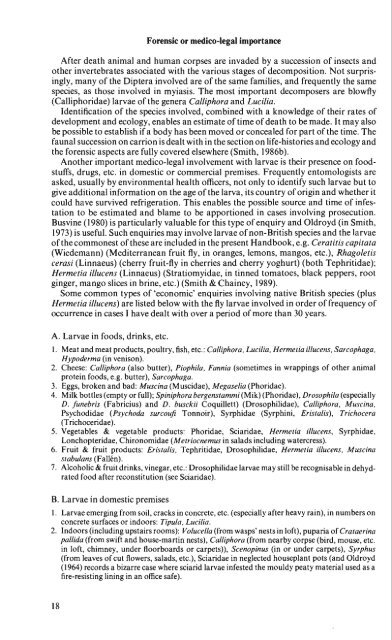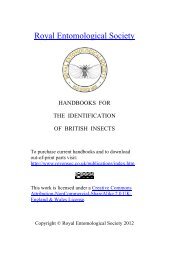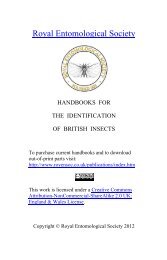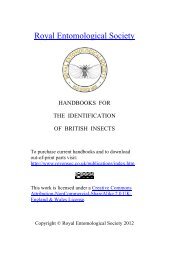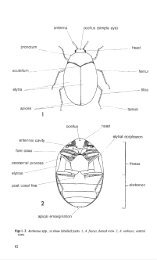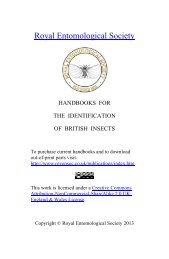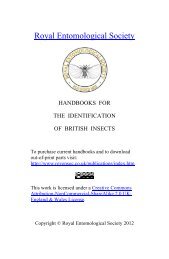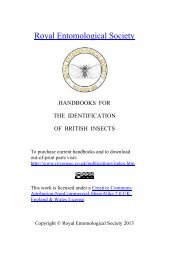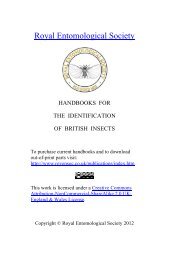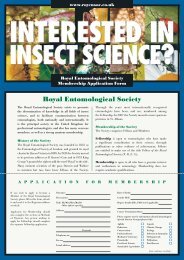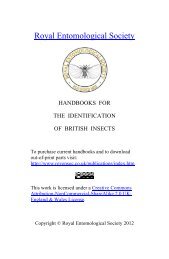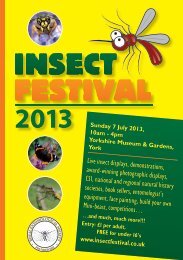Vol 10 Part 14. An introduction to the immature stages of British Flies ...
Vol 10 Part 14. An introduction to the immature stages of British Flies ...
Vol 10 Part 14. An introduction to the immature stages of British Flies ...
You also want an ePaper? Increase the reach of your titles
YUMPU automatically turns print PDFs into web optimized ePapers that Google loves.
Forensic or medico-legal importance<br />
After death animal and human corpses are invaded by a succession <strong>of</strong> insects and<br />
o<strong>the</strong>r invertebrates associated with <strong>the</strong> various <strong>stages</strong> <strong>of</strong> decomposition. Not surprisingly,<br />
many <strong>of</strong> <strong>the</strong> Diptera involved are <strong>of</strong> <strong>the</strong> same families, and frequently <strong>the</strong> same<br />
species, as those involved in myiasis. The most important decomposers are blowfly<br />
(Calliphoridae) larvae <strong>of</strong> <strong>the</strong> genera Calliphora and Lucilia.<br />
Identification <strong>of</strong> <strong>the</strong> species involved, combined with a knowledge <strong>of</strong> <strong>the</strong>ir rates <strong>of</strong><br />
development and ecology, enables an estimate <strong>of</strong> time <strong>of</strong> death <strong>to</strong> be made. It may also<br />
be possible <strong>to</strong> establish if a body has been moved or concealed for part <strong>of</strong> <strong>the</strong> time. The<br />
faunal succession on carrion is dealt with in <strong>the</strong> section on life-his<strong>to</strong>ries and ecology and<br />
<strong>the</strong> forensic aspects are fully covered elsewhere (Smith, 1986b ).<br />
<strong>An</strong>o<strong>the</strong>r important medico-legal involvement with larvae is <strong>the</strong>ir presence on foodstuffs,<br />
drugs, etc. in domestic or commercial premises. Frequently en<strong>to</strong>mologists are<br />
asked, usually by environmental health <strong>of</strong>ficers, not only <strong>to</strong> identify such larvae but <strong>to</strong><br />
give additional information on <strong>the</strong> age <strong>of</strong> <strong>the</strong> larva, its country <strong>of</strong> origin and whe<strong>the</strong>r it<br />
could have survived refrigeration. This enables <strong>the</strong> possible source and time <strong>of</strong> infestation<br />
<strong>to</strong> be estimated and blame <strong>to</strong> be apportioned in cases involving prosecution.<br />
Bus vine ( 1980) is particularly valuable for this type <strong>of</strong> enquiry and Oldroyd (in Smith,<br />
1973) is useful. Such enquiries may involve larvae <strong>of</strong> non-<strong>British</strong> species and <strong>the</strong> larvae<br />
<strong>of</strong> <strong>the</strong> commonest <strong>of</strong> <strong>the</strong>se are included in <strong>the</strong> present Handbook, e.g. Ceratitis capitata<br />
(Wiedemann) (Mediterranean fruit fly, in oranges, lemons, mangos, etc.), Rhago/etis<br />
cerasi (Linnaeus) (cherry fruit-fly in cherries and cherry yoghurt) (both Tephritidae);<br />
Hermetia il/ucens (Linnaeus) (Stratiomyidae, in tinned <strong>to</strong>ma<strong>to</strong>es, black peppers, root<br />
ginger, mango slices in brine, etc.) (Smith & Chainey, 1989).<br />
Some common types <strong>of</strong> 'economic' enquiries involving native <strong>British</strong> species (plus<br />
Hermetia illucens) are listed below with <strong>the</strong> fly larvae involved in order <strong>of</strong> frequency <strong>of</strong><br />
occurrence in cases I have dealt with over a period <strong>of</strong> more than 30 years.<br />
A. Larvae in foods, drinks, etc.<br />
I. Meat and meat products, poultry, fish, etc.: Calliphora, Lucilia, Hermetia illucens, Sarcophaga,<br />
Hypoderma (in venison).<br />
2. Cheese: Calliphora (also butter), Piophi/a, Fannia (sometimes in wrappings <strong>of</strong> o<strong>the</strong>r animal<br />
protein foods, e.g. butter), Sarcophaga.<br />
3. Eggs, broken and bad: Muscina (Muscidae), Megaselia (Phoridae).<br />
4. Milk bottles (empty or full); Spiniphora bergenstammi (Mik) (Phoridae), Drosophila (especially<br />
D. funebris (Fabricius) and D. busckii Coquillett) (Drosophilidae), Calliphora, Muscina.<br />
Psychodidae (Psychoda surcoufi Tonnoir), Syrphidae (Syrphini, Eristalis), Trichocera<br />
(Trichoceridae).<br />
5. Vegetables & vegetable products: Phoridae, Sciaridae, Hermetia illucens, Syrphidae,<br />
Lonchopteridae, Chironomidae (Metriocnemus in salads including watercress).<br />
6. Fruit & fruit products: Eristalis, Tephritidae, Drosophilidae, Hermetia illucens, Muscina<br />
stabu/ans (Fallen).<br />
7. Alcoholic & fruit drinks, vinegar, etc.: Drosophilidae larvae may still be recognisable in dehydrated<br />
food after reconstitution (see Sciaridae).<br />
B. Larvae in domestic premises<br />
I. Larvae emerging from soil, cracks in concrete, etc. (especially after heavy rain), in numbers on<br />
concrete surfaces or indoors: Tipu/a, Lucilia.<br />
2. Indoors (including upstairs rooms): <strong>Vol</strong>ucella (from wasps' nests in l<strong>of</strong>t), puparia <strong>of</strong> Crataerina<br />
pallida (from swift and house-martin nests), Calliphora (from nearby corpse (bird, mouse, etc.<br />
in l<strong>of</strong>t, chimney, under floorboards or carpets)), Scenopinus (in or under carpets), Syrphus<br />
(from leaves <strong>of</strong> cut flowers, salads, etc.), Sciaridae in neglected houseplant pots (and Oldroyd<br />
(1964) records a bizarre case where sciarid larvae infested <strong>the</strong> mouldy peaty material used as a<br />
fire-resisting lining in an <strong>of</strong>fice safe).<br />
18


